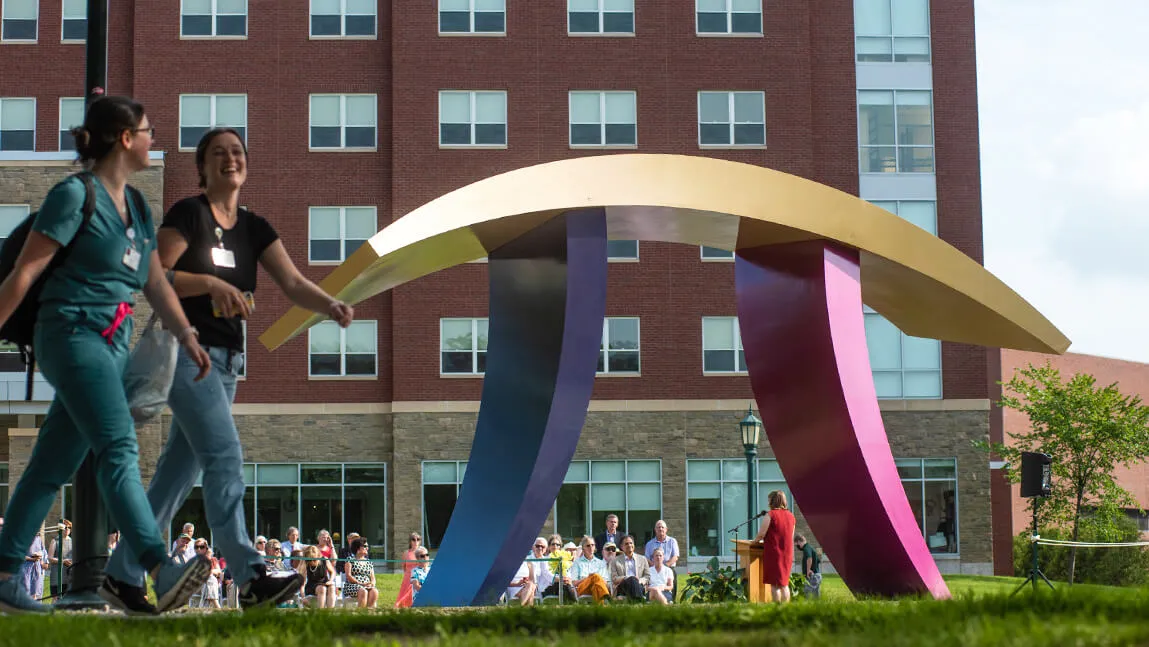Building on the University of Vermont’s collection of public art, a freestanding sculpture by artist David Stromeyer, “Tango,” was installed on campus, in front of the Science, Technology, Engineering and Mathematics Complex, on August 9. The tall piece — made of steel, painted in three colors, and reminiscent of the mathematical symbol pi — comes to UVM from Stromeyer’s Cold Hollow Sculpture Park in Enosburg Falls, Vt., where it has resided since its creation in 2008.
In a sun-soaked ceremony, two UVM presidents joined the sculptor in cutting a ribbon and formally presenting the artwork. Current UVM President, Suresh Garimella, dedicated the sculpture to President Emeritus and Professor of Political Science Thomas Sullivan, saluting the former president’s “devotion to public art and his ongoing efforts to enliven the UVM campus with a variety of diverse and compelling works.”
“This is a place to stop and ponder the intersection of art, nature, and science,” Garimella said to the dozens of members of the UVM community gathered on the green where the sculpture now resides between the new science and engineering complex to the west, the Fleming Museum to the north, and the Central Campus Residence Hall to the south.
At 14 feet high, 10 feet wide and 24 feet long, the painted steel piece joins the ranks of Paul Aschenbach’s “Tree of Knowledge” — located outside of Howe Library — as one of the tallest sculptures on campus.
Through the arch
“Tango is efficient and, I feel, beautiful, like a mathematical proof. There are no extra steps. Everything that is there, must be there,” said its creator, David Stromeyer, in his comment during the ceremony, reflecting on the process of creating sculpture and his forty-year history of displaying works at UVM. He thanked Tom Sullivan for his vision and support of arts, but did confess: “while I started as a mathematics major at Dartmouth College, ‘Tango’ is not inspired by pi.” Instead, Stromeyer pointed to passageways as a primary inspiration.
Stromeyer sees “Tango” as “visually kinetic play on a portal, gateway or arch. In concept, it is closer to a [Japanese] torii gate, which marks a transition or passage from the mundane to the sacred,” he noted in comments prior to the ceremony. Traditionally, torii gates are large red or black structures found at Shinto shrines, and feature a top archway that is inverted, with its ends pointing up to the sky.
“There is a very long history of arches and gateways celebrating passage, which strikes me as an appropriate theme for the discovery and launching that UVM fosters,” Stromeyer said.
The Cold Hollow Sculpture Park describes “Tango” as “a dynamic, yet solid piece” that visitors have long enjoyed“because, paradoxically, this work appears both stable and on-the-move...‘Tango’ transforms a utilitarian space into a thought-provoking place.” Its name refers to the dramatic ballroom dance, evoking the energy and graceful twists and movements associated with it, and with its seemingly familiar shape,the placement of Stromeyer’s “Tango” outside the STEM Complex is not unintentional. Though Stromyemer doesn’t identify the piece as a reflection of the mathematical symbol, Sullivan concluded his remarks saying, “This is a beautiful, inspiring public sculpture that we now love to call ‘Tango,’ and with all due respect, perhaps, ‘Pi.’”
“Tango” first caught Sullivan’s eye in August 2019 while visiting Stromeyer’s park after his seven-year tenure as the 26th president of UVM. His presidency between 2012 and 2019 is marked by dramatic campus revitalization including new and improved buildings such as the STEM Complex and various public art installations.

Movement
Opening the dedication ceremony, UVM professor of Art History Kelley Helmstutler Di Dio praised Stromeyer’s sculptures, including “Tango,” saying, “they create and reshape space through form, line and color. His bold sculptures could easily overwhelm the viewer by their scale, and could seem disconsonant with their natural surroundings. And yet they connect with the viewer, and with their physical context, in ways that alter and evolve as you move around them.”
"Tango” is the latest permanent addition to the university’s growing public art collection, which features abstract, pop-art–inspired, and contemporary sculptures from artists and alumni including “Flukes” by Gordon Gund P’91, P’93; “Sparkle Pony” by Kat Clear ’01; “Unlocked” by Christopher Curtis ’74; “Bus Ball” by Lars Fisk ’93 and “Areté Blu” by Richard Erdman ’75, H’16.
Take a virtual tour the art and sculptures that adorn the University of Vermont campus.
